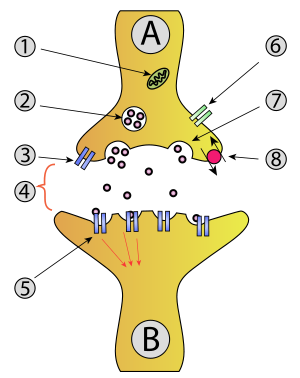Introduction to Parkinson's Science/Dopamine production and storage
There are many images on the web which illustrate how dopamine is produced in the neurons, stored in vesicles, released and taken up again and these are usually under copyright. (Try going to Google images and searching for 'dopamine vesicles').
Here is a link to another, more detailed image: http://www.biolsci.org/ms/getimage.php?name=ijbsv06p0133g02.jpg In the diagram VMAT stands for vesicular monoamine transporter. (Dopamine is a monoamine.)
The left hand side of the image at the following link also illustrates dopamine production, storage and recycling very well and gives a good description: http://jnm.snmjournals.org/content/51/7/1001/F1.expansion.html

1. Mitochondrion
2. Synaptic vesicle with neurotransmitters
3. Autoreceptor
4. Synapse with neurotransmitter released
5. Postsynaptic receptors activated by neurotransmitter (induction of a postsynaptic potential)
6. Calcium channel
7. Exocytosis of a vesicle
8. Recaptured neurotransmitter
|
Use CTRL-Left Click to open an external link in a separate tab in your browser. Use Shift-Left Click to open it in a separate browser window. |
The production and recycling of dopamine in the neurons goes basically like this:
- The enzyme tyrosine decarboxylase (TH) converts typrosine into levodopa in the cytosol of the cell
- Aromatic amino acid decarboxylase (AAADC) converts levodopa into dopamine
- The dopamine is removed from the cytosol by vesicular monoamine transporters (VMAT) and stored in vesicles in the nerve terminal.
- When the dopamine is needed and the neuron fires, a vesicle migrates to the membrane and the dopamine is released by exocytosis into the synapse - the tiny gap between the neurons.
- Much of the dopamine passes across the synapse to bind to the dopamine receptors on the receiving nerve cell. The action of binding to the receptors (of which there are a number of varieties, D1, D2, D3 etc) change the activity of the latter cell.
- Dopamine which remains free or is released from the receptors is taken up by dopamine transporters (DAT) on the transmitting neuron. Any which still remains free is degraded by monoamine oxidase.
- Dopamine re-entering the cytosol through the DATs is taken up into the vesicles again. It is stored away this way because free dopamine would be damaging to the cell because it undergoes autoxidation to produce reactive oxygen species.
